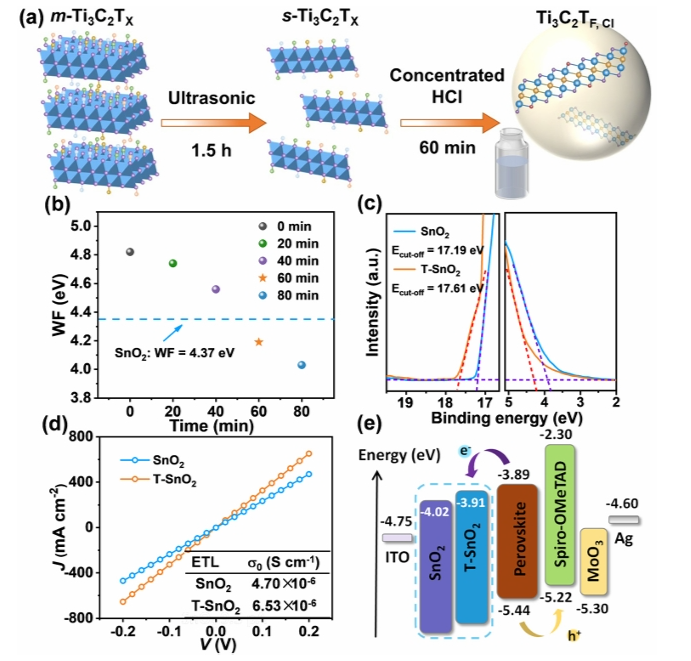Chlorinated-Ti3C2TF as a dual-functional buried interface on SnO2 electron-transporting layers for 25.09 % high-performance n-i-p perovskite solar cells
Ji Cao1,2,Qiaoyun Chen1,Wenting Wu1,Jianfei Fu1,3,Zelong Zhang1,Lei Chen4,Rui Wang1,2,Wei Yu1,2,Lijie Wang1,Xiaoting Nie1,2,Jing Zhang4,Yi Zhou1,2*(周祎),Bo Song 1 *(宋波), Yongfang Li1,2,5 *(李永舫)
1College of Chemistry, Chemical Engineering and Materials Science, Soochow University, Suzhou 215123, P. R. China.
2Laboratory of Advanced Optoelectronic Materials, Suzhou Key Laboratory of Novel Semiconductor-optoelectronics Materials and Devices, P. R. China
3School of Materials Science and Engineering (MSE), NingboTech University, Ningbo, 315211, P. R. China
4School of Material Science & Engineering, National Experimental Demonstration Centre for Materials Science and Engineering, Jiangsu Province Cultivation Base for State Key Laboratory of Photovoltaic Science and Technology, Changzhou University, Changzhou 213164, Jiangsu, P. R. China
5Beijing National Laboratory for Molecular Sciences, CAS Key Laboratory of Organic Solids, Institute of Chemistry, Chinese Academy of Sciences, Beijing 100190, P. R. China
Energy Environ. Sci., 2024,17, 3454-3469
Abstract:Fluorinated titanium carbide MXenes (Ti3C2TF) have been proven as interfacial materials for hole transport layers in perovskite solar cells (pero-SCs). The surface terminals of Ti3C2TF can be adjusted to regulate the work function (WF) of electron transport layers (ETLs). In this work, Ti3C2TF,OH,O was treated with HCl to obtain Cl-terminated Ti3C2TF (named Ti3C2TF,Cl). The resulting Ti3C2TF,Cl was employed as a buried interlayer between SnO2 and the perovskite, which provides the dual functions of reducing the WF of SnO2, leading to good ohmic contact between the ETL and the perovskite, and facilitating the growth of the perovskite and reducing lattice stress via alteration of the surface energy of the ETL and lattice matching with the perovskite. n–i–p pero-SCs based on FA0.92MA0.08PbI3 achieved an excellent power conversion efficiency (PCE) of 25.09% with an open circuit voltage of 1.18 V. The optimized pero-SCs exhibit improved stability in N2, light soaking conditions, and air with a relative humidity of 30–40%. Additionally, Ti3C2TF,Cl performs well in large-scale devices (1.1 cm2) with a PCE of 20.62%, and is adaptable to pero-SCs with different perovskite (FA0.85MA0.15PbI2.55Br0.45), which achieves an exceptional PCE of 24.05% and a high fill factor of 84.52%.

链接://pubs.rsc.org/en/content/articlelanding/2024/ee/d4ee00196f